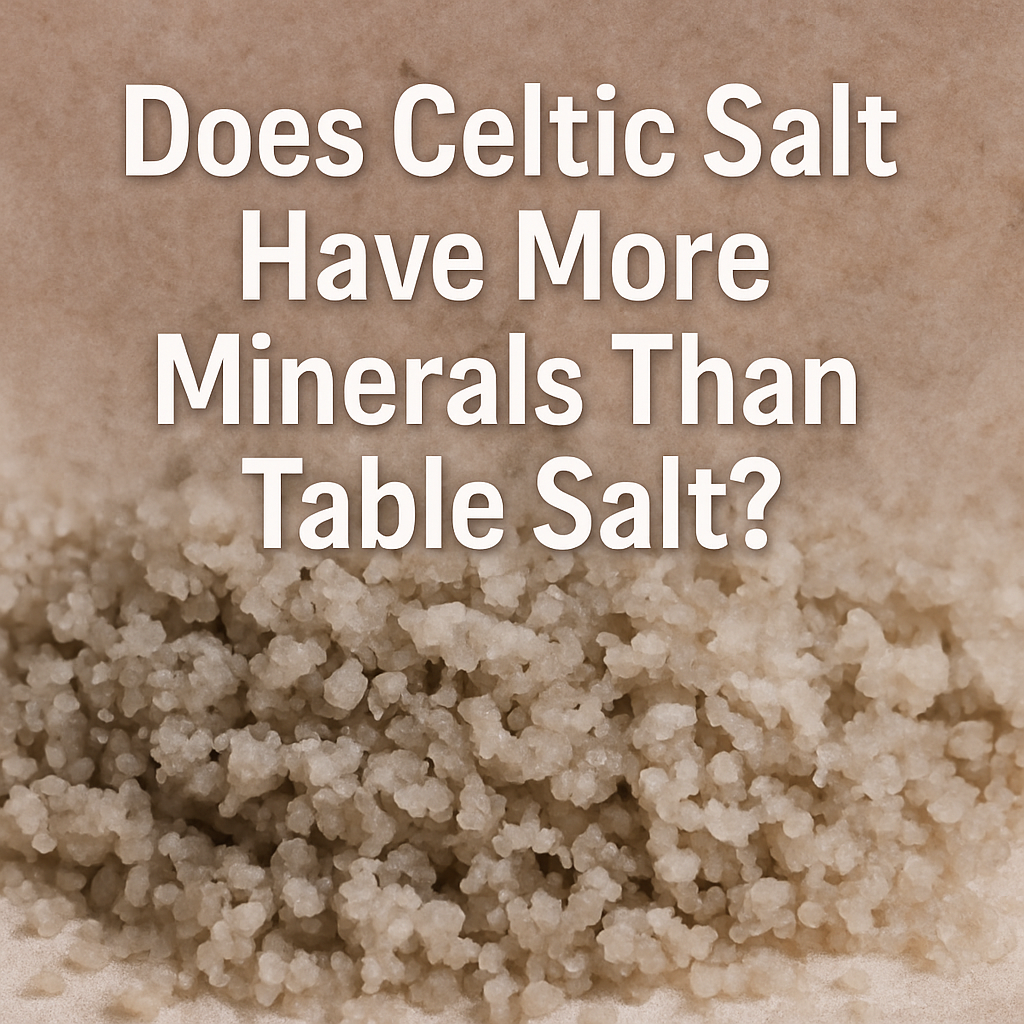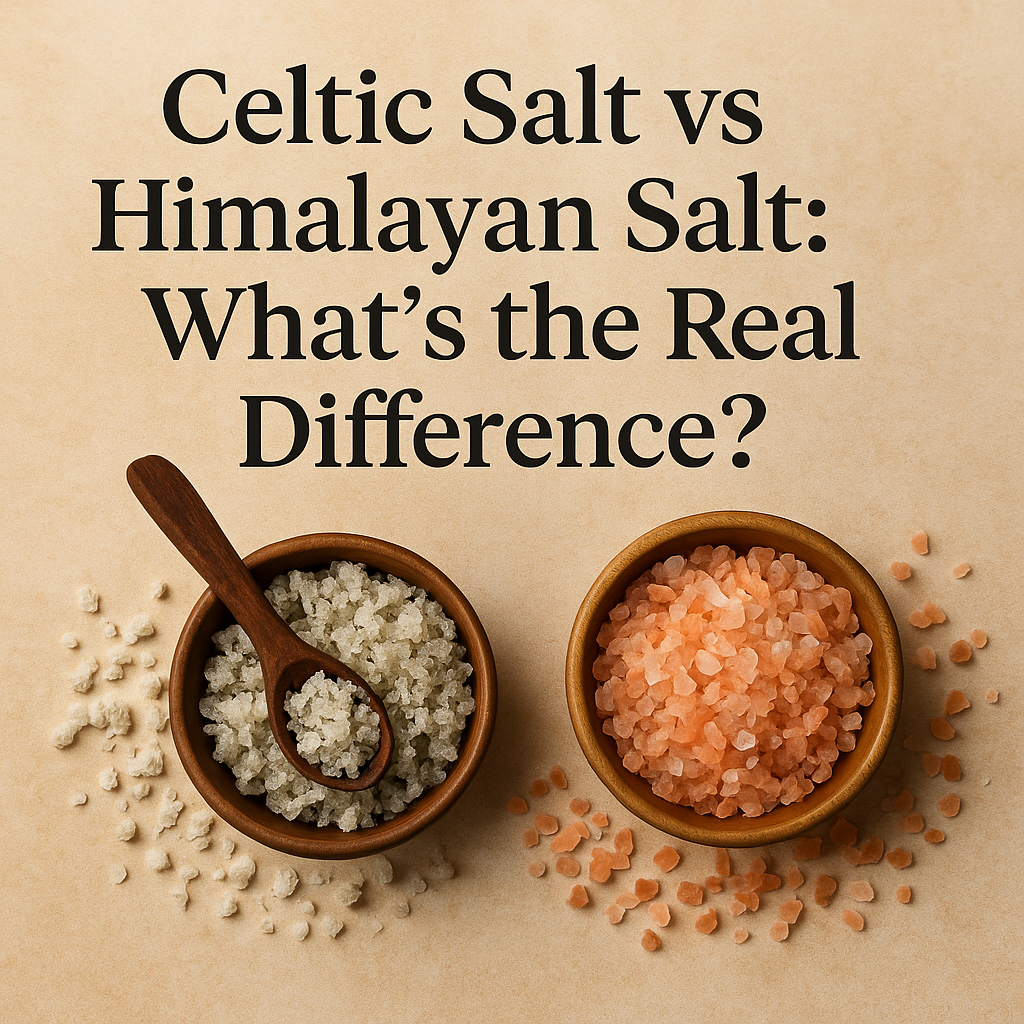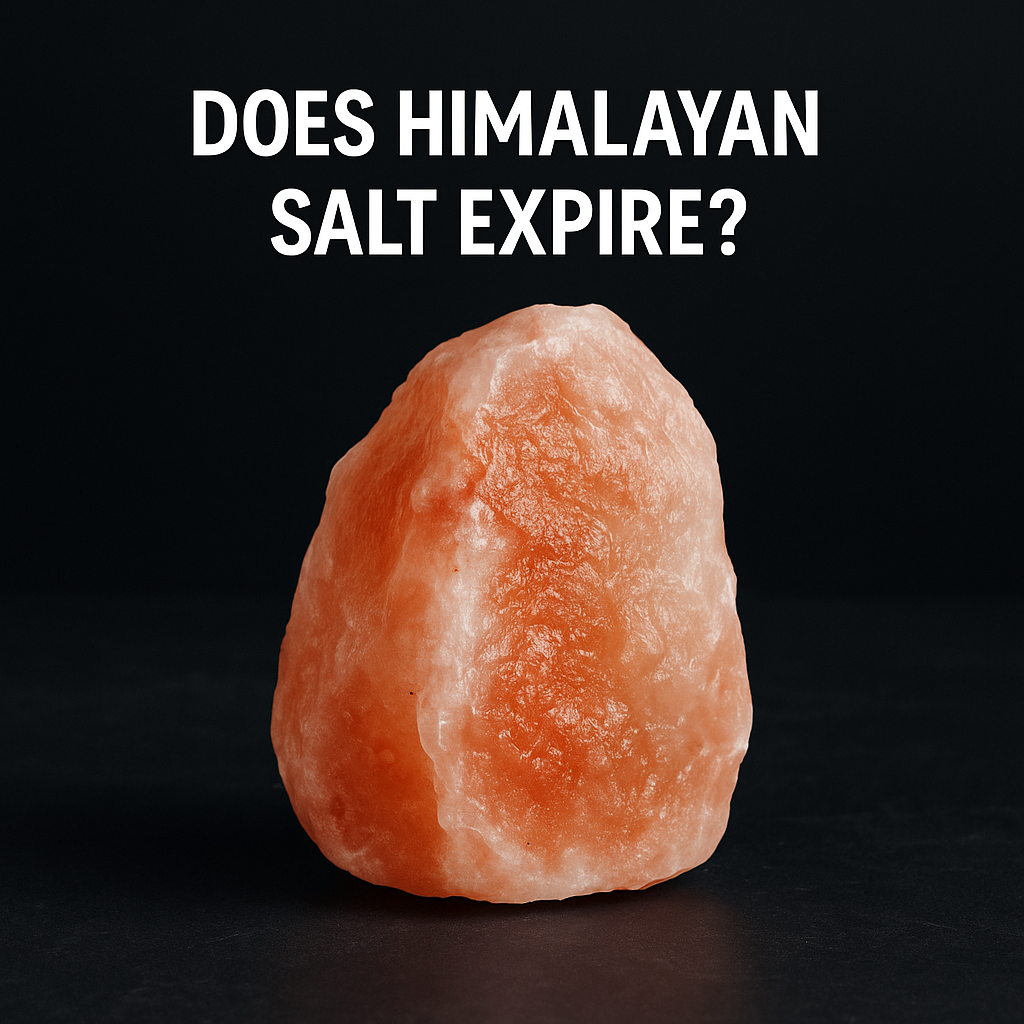When you look at two jars, one with pink Himalayan salt and the other with white sea salt, it’s easy to wonder which one is actually better for you. The topic of Himalayan Salt vs Sea Salt often comes up when people want to make healthier, more natural choices.
Both look similar but differ in their origins, minerals, and how they impact your health. This blog explains how each salt is formed, what makes them different, and which one may be the better option for your body and everyday use.
What is Himalayan Salt
Himalayan pink salt comes from the Khewra mines in Pakistan. These mines have ancient ocean deposits that formed over 250 million years ago. Its natural purity and mineral balance make it one of the cleanest salts on earth. Learn more about Himalayan Salt.
How Sea Salt Forms and What Makes It Different
Sea salt is made through the evaporation of seawater. Producers collect the water in shallow ponds, let the sun and wind do the drying, and then gather the remaining salt crystals. Because it forms from evaporated seawater, it retains some natural minerals that add taste and texture variety.
The mineral makeup depends on the ocean source. For example, Mediterranean sea salt may taste different from Atlantic sea salt. This is because the minerals in the local seawater are not the same.
Modern sea salts are usually filtered before drying. However, since they come from open oceans, they may still have small amounts of contaminants. These can include microplastics or pollutants if the source is not properly managed. This doesn’t make them unsafe, but it highlights the importance of choosing reputable brands.
When comparing Himalayan salt vs sea salt, the key difference lies in purity and geological age. Some people view sea salt vs Himalayan as a debate between modern freshness and ancient purity. Himalayan salt is ancient and untouched, while sea salt is newer and exposed to today’s environment.
Himalayan Salt vs Sea Salt: Mineral Content and Key Differences
Both Himalayan salt and sea salt contain sodium chloride, but their mineral composition and purity levels set them apart. Understanding how their minerals differ helps you choose the right type for cooking and overall wellness.
-
Himalayan pink salt contains more than 80 trace minerals, although in very small amounts. These include magnesium, potassium, calcium, and iron.
-
The presence of iron oxide gives Himalayan salt its pink colour and adds a mild, earthy flavour that makes it distinct from other salts.
-
Sea salt also contains minerals, but the type and amount depend on where it’s harvested and how it’s processed. Some sea salts are naturally rich in magnesium or iodine, while others are almost pure sodium chloride.
-
Many people compare pink Himalayan vs sea salt to understand mineral benefits, but in reality, the nutritional difference is minor. The trace minerals are present, yet too minimal to significantly affect health.
If you’d like to see how it compares to regular salt, check out our blog on Pink Himalayan Salt vs Table Salt
-
One of the subtle advantages of Himalayan pink salt is its purity and natural balance. It remains free from modern pollutants and keeps a clean mineral profile, making it a safe choice for long-term use.
Taste, Texture, and Everyday Use
While both salts enhance flavour naturally, they offer very different experiences when it comes to taste, texture, and how they interact with food. Understanding these differences helps you use each one more effectively in daily cooking.
-
Himalayan pink salt has a softer, rounder flavour compared to table salt. The grains are dense and dissolve slowly, giving a smooth, balanced taste without the sharpness of processed salts.
-
It’s great for finishing dishes, seasoning meats, or even as a salt rim on drinks because it adds flavour gradually instead of overpowering the food.
-
Sea salt delivers a crisp, briny taste and usually comes in light, flaky textures that melt quickly on the tongue. Chefs often use it to finish seafood, roasted vegetables, or salads for that natural ocean-like flavour.
-
Some types, such as Celtic sea salt, retain moisture, giving them a slightly damp texture that adds a distinct feel when sprinkled on food.
Both Himalayan salt and sea salt can replace refined table salt in recipes. However, their grain size and density affect the amount of sodium they provide.
Finely ground salts are denser. This means a teaspoon of Himalayan pink salt has almost the same sodium as table salt, about 2,200–2,300 mg. Flaky sea salt, on the other hand, usually contains less because the larger flakes take up more space in the spoon.
How Each Salt Affects Health
The question most people ask is simple: Is sea salt good for health, or is Himalayan better?
Here’s what’s worth knowing.
Both salts are unrefined, which means they’re free from additives like bleaching agents or anti-caking chemicals. That’s already a big win compared to regular table salt. The main difference is in their trace minerals and purity.
Himalayan pink salt is generally considered gentler on the stomach and may help balance electrolytes when used in small amounts. It’s also used in bath soaks for muscle relaxation and skin hydration, which is something not often associated with sea salt.
Sea salt, being freshly harvested, may contain natural iodine if not heavily refined. This can support thyroid function, but again, the quantity is minimal. The healthiest choice comes down to moderation. Too much of any salt, even the purest kind, can raise blood pressure and strain the kidneys.
Advantages of Himalayan Pink Salt
People often use Himalayan pink salt beyond cooking, and this is where it truly stands apart.
Natural Air Purification
When used in Himalayan salt lamps, it can help absorb moisture and pollutants from the air, leaving your environment feeling fresher. While not a substitute for an air purifier, it’s a natural way to improve ambiance and reduce airborne irritants.
Skin and Body Detox
Adding Himalayan salt to warm baths helps draw out impurities, relax muscles, and balance skin hydration. The minerals dissolve into the water, creating a soothing soak that feels like a natural spa treatment.
Improved Hydration
Some people mix a pinch of Himalayan salt in water, creating what’s known as “sole water.” It’s believed to support hydration and electrolyte balance, especially in hot climates or after workouts. It’s not a medical treatment, but it’s a simple trick that many athletes use.
Food Preservation and Taste
Because of its mineral balance, Himalayan salt holds flavour longer and can help preserve foods naturally without artificial preservatives.
If you’re wondering whether Himalayan salt lasts forever or changes over time, you can read our blog on does Himalayan salt expire
Advantages of Sea Salt
Sea salt is one of the most natural and versatile salts used in kitchens worldwide. It offers flavour, texture, and subtle health benefits that make it a strong alternative to refined table salt. Here’s a complete look at what makes sea salt good for health and cooking.
Rich in Trace Minerals
Sea salt contains small amounts of essential minerals such as magnesium, potassium, calcium, and zinc. These trace elements help the body maintain hydration, nerve communication, and muscle function. Though present in low levels, they make sea salt a cleaner and more natural option than processed table salt.
Naturally Produced and Chemical-Free
Unlike refined salts, sea salt is harvested through the evaporation of seawater under the sun. This simple process keeps it free from artificial chemicals, anti-caking agents, and bleaching additives, preserving its natural mineral composition.
Available in Different flavours and Textures
Depending on the source, sea salt can range from fine grains to large, flaky crystals. This variation lets you choose how it interacts with your food — from adding crunch to delivering quick, even seasoning. It’s ideal for seafood, vegetables, salads, and even baking.
Source of Natural Iodine
Unrefined sea salts often contain traces of iodine, which supports healthy thyroid function. While not a replacement for iodized salt, it still offers a gentle, natural way to include iodine in your diet.
Enhances the Natural flavour of Food
Sea salt delivers a clean, crisp taste that brings out the natural flavours in food instead of overpowering them. A small pinch at the end of cooking can make a noticeable difference in freshness and balance.
Useful for Skincare and Relaxation
Beyond the kitchen, sea salt is commonly used in skincare and spa treatments. It acts as a gentle exfoliant in scrubs and can be added to baths to soothe tired muscles and refresh the skin.
Common Myths About Himalayan Salt vs Sea Salt
-
Himalayan salt detoxifies the body
This is one of the most common misconceptions. Himalayan salt helps maintain hydration and electrolyte balance, but it doesn’t detoxify your body. Detoxification happens naturally through your liver and kidneys, not by eating salt.
-
Sea salt is always clean and pure
Many assume sea salt is naturally cleaner, but modern oceans contain microplastics and pollutants. If the salt isn’t properly filtered, small traces can remain. Himalayan pink salt, being mined from ancient deposits sealed underground, is protected from today’s pollution.
-
Himalayan salt has no sodium effect
Both Himalayan salt and sea salt are forms of sodium chloride. While Himalayan salt contains trace minerals, it still contributes to sodium intake. The healthiest approach is using it in moderation, not as a complete substitute.
Which One Should You Use Daily?
If you care about mineral balance, purity, and taste, you should lean towards Himalayan pink salt rather than sea salt. It offers clean, stable minerals and is sourced far from environmental contaminants. It’s a great option for cooking, seasoning, and even for wellness uses like lamps or baths.
If you enjoy the crisp, briny texture of sea salt on food, it still has a place in your kitchen. Just ensure it’s sourced from trusted suppliers who test for pollutants.
In short, both are far better choices than refined salt, but Himalayan salt stands out for its age, purity, and versatility.
Final Thoughts
Between Himalayan Salt vs Sea Salt, the healthier choice depends on what you value more — modern freshness or ancient purity. Himalayan salt gives you an untouched, mineral-rich option that has been forming for millions of years under layers of rock. It’s naturally filtered, additive-free, and suited for both culinary and wellness uses.
Sea salt is still a good option, but it carries the footprint of today’s oceans. If your goal is to get the cleanest salt possible with a smoother flavour and multiple benefits, Himalayan pink salt takes the lead.
Bring the Purity Home with Himalayan Salt Direct
At Himalayan Salt Direct, we provide genuine Himalayan pink salt that’s carefully mined from the Khewra region, naturally dried, and completely free from chemicals or additives. Our salt keeps its natural minerals and clean taste just as nature made it.
You can use it for everyday cooking, seasoning, salt lamps, or soothing himalayan salt bath. Each product is made to deliver pure, safe, and high-quality Himalayan salt for your home and wellness routine.
Shop at Himalayan Salt Direct to enjoy fresh, authentic Himalayan salt and experience clean, natural quality in every use.
Frequently Asked Questions About Himalayan Pink Salt vs Sea Salt
Which salt is more healthier, sea salt or Himalayan salt?
Both salts are more natural and less processed than regular table salt, but Himalayan salt is generally considered purer. It comes from old sea deposits that are protected from pollution.
It has small amounts of minerals like magnesium, potassium, and calcium. Sea salt, while also rich in minerals, can sometimes contain traces of modern ocean pollutants. Himalayan salt is a bit more pure and has better minerals. However, both types are healthy if used in moderation.
Can I use pink Himalayan salt instead of sea salt?
Yes, you can easily replace sea salt with pink Himalayan salt in any recipe. It has a smooth, mild flavour that enhances food naturally. Because it’s denser, a smaller amount of Himalayan salt gives the same saltiness as sea salt. It’s great for everyday cooking, baking, or as a finishing touch, and even works for wellness uses like salt baths and detox soaks.
Is Himalayan salt better than sea salt?
Himalayan salt is often preferred for its purity and clean mineral profile. It comes from old rock formations that have not been affected by modern pollution.
It has trace minerals that add colour and a milder taste. Sea salt, depending on where it’s harvested, may contain small traces of microplastics. Himalayan pink salt is a cleaner and more natural choice for daily use. However, both options are good if you choose high-quality, unrefined types.







